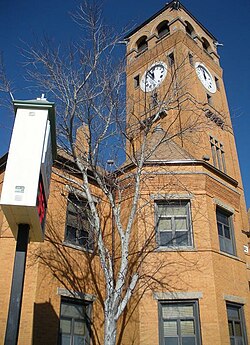Tuskegee, AL
| Tuskegee, Alabama | |
|---|---|
| City | |

The Macon County Courthouse in Tuskegee was added to the National Register of Historic Places on November 17, 1987
|
|
| Nickname(s): Thou Pride of the Swift Growing South | |
 Location of Tuskegee in Macon County, Alabama. |
|
| Location in the United States | |
| Coordinates: 32°25′53″N 85°42′24″W / 32.43139°N 85.70667°W | |
| Country | United States |
| State | Alabama |
| County | Macon |
| Government | |
| • Mayor | Lawrence F. Haygood, Jr. |
| Area | |
| • Total | 16.37 sq mi (42.40 km2) |
| • Land | 16.11 sq mi (41.73 km2) |
| • Water | 0.26 sq mi (0.67 km2) |
| Elevation | 463 ft (141 m) |
| Population (2010) | |
| • Total | 9,865 |
| • Estimate (2016) | 8,722 |
| • Density | 541.34/sq mi (209.01/km2) |
| Time zone | CST (UTC-6) |
| • Summer (DST) | CDT (UTC-5) |
| ZIP codes | 36083, 36087, 36088 |
| Area code(s) | 334 |
| FIPS code | 01-77304 |
| GNIS feature ID | 0128211 |
| Website | http://www.tuskegeealabama.gov/ |
Tuskegee (/tʌsˈkiːɡiː/) is a city in Macon County, Alabama, United States. It was founded and laid out in 1833 by General Thomas Simpson Woodward, a Creek War veteran under Andrew Jackson, and made the county seat that year. It was incorporated in 1843. It is also the largest city in Macon County. At the 2010 census the population was 9,865, down from 11,846 in 2000.
Tuskegee has been an important site in African-American history and highly influential in United States history since the 19th century. Before the American Civil War, the area was largely used as a cotton plantation, dependent on African-American slave labor. After the war, many freedmen continued to work on plantations in the rural area, which was devoted to agriculture. In 1881 the Tuskegee Normal School (now Tuskegee University, a historically black college) was founded and its director, Booker T. Washington developed a national reputation and philanthropic network to support education of freedmen and their children.
In 1923, the Tuskegee Veterans Administration Medical Center was established here, initially for the estimated 300,000 African-American veterans of World War I in the South, when public facilities were racially segregated. Twenty-seven buildings were constructed on the 464-acre campus.
...
Wikipedia

